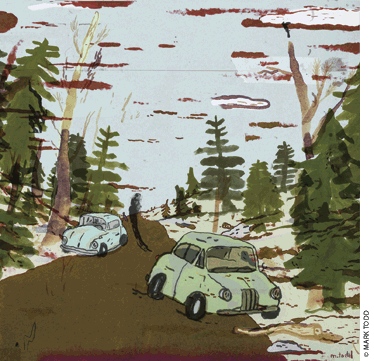
Retracing John McPhee’s steps in the Pine Barrens.
By Molly Petrilla | Fred Brown’s only heat came from a wood-burning stove. His two-story house lacked running water and electricity, and his floors were made from dirt. He lived in the New Jersey Pine Barrens, about 25 miles from the nearest supermarket, and eight rusting cars sat on his front lawn.
These details aside, Fred Brown and I had a few things in common: We both liked pork chops, we both ate raw onion slices, and we both had a penchant for spending time alone. So when my Advanced Nonfiction Writing professor, Bob Strauss, decided my class would exchange the comforts of the Kelly Writers House for a taste of the Barrens one afternoon, I knew I would feel right at home.
Of course, we wouldn’t actually be meeting Fred Brown or seeing his house—I mean, the guy was 79 years old when John McPhee wrote about him in 1968; do the math—but we’d get a taste of the general area where McPhee had befriended him and spent hours observing his daily routines and learning about his life.
Though it was slightly dense, I’d actually enjoyed the excerpt we’d read that week from McPhee’s The Pine Barrons. Living in central Jersey, I’d passed through the Barrens dozens of times on trips to the beach with my parents, but I’d never really thought of them as anything special. In fact, until McPhee’s lyrical, somewhat depressing piece, I’d just associated them with the monotonous stretch of road that always made my allergies act up.
It was to be a three-hour trip, much like that of the ill-fated Gilligan. We met for class a few minutes before 2 p.m. and divided our group of 10 among three cars.
“You know how to get there, right?” Bob asked the drivers-elect—two classmates who kept vehicles with them on campus.
They said they did, so we headed for the New Jersey wilderness without even exchanging cell-phone numbers. At the front of our group, Bob’s emerald-colored car shone in the sunlight just as I’d always imagined that light at the end of the dock did in The Great Gatsby. Except instead of representing the intangible, Bob was guiding us toward the very tangible—the tree-filled Pine Barrens.
But before we even left campus, my friend’s car—the last in the line of three, and the one in which I’d chosen to ride—somehow lost sight of this glimmering beacon. (Not that it was really our fault. Who knew a couple wrong turns could land you on the Ben Franklin Bridge instead of I-95?).
After a few emergency phone calls to my friend’s boyfriend, who had ready access to Mapquest, we got ourselves straightened out, and eventually spotted the other two cars at the side of the highway in Jersey. Bob was pacing the narrow strip of asphalt next to his car.
“Where were you guys?” he asked. He wasn’t angry, just concerned.
We produced a few embarrassed giggles and told him what had happened.
“It’s fine,” he said. “We’re almost there, anyway.”
We drove for several miles more, sticking close this time. Then Bob made a quick right turn onto a sand road almost completely obscured by the thick evergreens surrounding it. We watched as he forced his car up the slight slope until the sand reached its bumper. Though in our reading selection McPhee had said that “it is possible to drive all day on the [barrens’] sand roads”—noting that many hunters, foresters, firefighters, and woodcutters actually do—it appeared we city folk couldn’t.
Once Bob’s car could go no further into the barrens, the other two cars parked behind him on flatter, thinner sand.
I sprang out of my friend’s car, eager to get in touch with my country-girl side.
“Let’s just start walking and see where the path takes us,” Bob suggested.
That sounded like an acceptable idea—maybe even something ole Fred did for fun.
But just a few minutes into our traipse down the sandy path, I realized what poor choices I’d made getting dressed that morning. It was a hot day, so I’d put on flip flops, a tank top, and a short jean skirt. My feet were covered with dirt in seconds, and several generations of gnats soon came to feast on my exposed flesh. While flicking a large deerfly off my thigh, I reminded myself that if Fred Brown could do without electricity, I could forgo bug spray.
Since my flip flops had to be cleaned off every few steps, I soon fell to the back of the group. Just before tripping over a large root, I looked up and saw my more suitably dressed classmates at the front of the line take a sharp left off the path.
When I reached the clearing and turned left into it, too, I spied them out in the middle of a bog, picking bright red berries.
I remembered that Fred Brown’s house had been on “an unpaved road that curve[d] along the edge of a wide cranberry bog.” I also remembered how his friend and neighbor, Bill Wasovwich, had received some acreage from a cranberry grower, and was “building a small cranberry bog of his own, ‘turfing it out’ by hand.” I grew excited at the thought of learning to turf a bog.
“Come on, guys, check this out,” Bob said.
I took a step forward, but my left flip flop stayed behind.
“I can’t,” I said, sounding like a priss even to myself. The bog was part water and part sticky mud, and I decided it was better to forgo the berry area than sacrifice my footwear.
Somewhere between the bog and our next stop—a pile of mysterious bones that looked suspiciously like old fried chicken—one of the guys picked up a giant stick. As he walked with it the rest of the way back, his wavy hair flopping in the breeze, I ignored his designer jeans and imagined a young Fred Brown.
I was still admiring this young man’s master-of-the-wilderness look when we returned to our vehicles and encountered a slight problem. Bob’s car wouldn’t budge.
“Try flooring it,” someone suggested.
The wheels barely spun, and the car didn’t move.
I thought of McPhee’s description of Fred Brown’s lawn, which contained eight old cars, only one of which still worked. All of the cars were at least 10 years old, some much older; two lay on their sides, and one was upside down. Aside from the working car, a 1956 Mercury, the others “had at one time or another been his best car, and each, in turn, had lain down like a sick animal and had died right there in the yard, unless it had been towed home after a mishap elsewhere in the Pines.”
“We’ll dig it out,” someone else offered, likely compelled to take action by the same frightening information I’d been recalling.
As we girls watched, the boys crawled on the dirty sand and dug out one of Bob’s tires. It still wasn’t enough—they soon saw they would have to dig out all the tires and the sand packed under the front of his car for it to even have a chance of moving.
At that point, I was certain that, like Fred Brown, I would be relegated to a life amid the trees, without wireless Internet or 24/7 access to the Fresh Grocer.
After more than half an hour of digging, pushing, and cursing, the guys somehow got Bob’s car moving again. Riding high on their victory, they exchanged a few high fives.
“That was awesome!” exclaimed one classmate, a wrestler.
Though the other guys didn’t look quite as enthusiastic, they seemed pretty pleased with themselves. Bob allowed them a few more moments of glory, and then summoned us back to our cars for a happily uneventful ride back to Philly.
Now, several months later, I’m living in central Jersey again and working as a reporter. Though I haven’t been back to the Barrens yet, there’s something oddly comforting about knowing they’re still there, in all the “undulating sameness” McPhee witnessed four decades ago.
And who knows—maybe one day, if I get desperate for material, I’ll drive out there again and search for a subject as enigmatic as Fred Brown.
Molly Petrilla C’06 enjoys nature (most of the time). She is a staff writer for a weekly newspaper, and spends her free time reading and getting lost on back roads.




